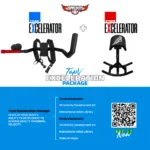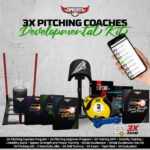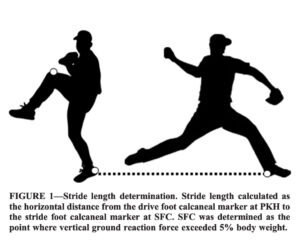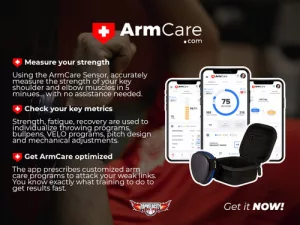 This article has what every parent needs to learn about Little League Pitch Count!
This article has what every parent needs to learn about Little League Pitch Count!
Little League baseball serves as a foundational platform for developing young talent and cultivating a passion for the sport among children. It's at this early stage where the basics of baseball are taught and where young athletes begin to form their lifelong connections to the game. As these young players grow and their skills develop, the excitement and competitive nature of the sport intensify. However, this developmental stage also brings forth significant challenges, particularly in managing the physical demands placed on young pitchers.
One of the primary concerns in Little League baseball is the management of pitch counts. Pitch counts are regulated to prevent overuse injuries, which are common in young athletes whose bones and muscles are still developing. Overuse injuries can lead to serious conditions such as Little League elbow or shoulder, which can affect players long-term, potentially hindering their progression in the sport.
The complexity of managing pitch counts lies not only in adhering to strict limits but also in balancing the development of a pitcher’s skills with their physical well-being. Coaches and leagues must navigate various obstacles, such as ensuring all team members are educated about the importance of these limits and effectively monitoring adherence during games, which can often be hectic and fast-paced.
This article aims to delve into the complexities of managing pitch counts in Little League baseball, providing a comprehensive overview of the problems faced and proposing practical solutions. Through insights from coaches, sports health professionals, and the latest research, we explore how these challenges can be addressed to protect young athletes while still allowing them to thrive and develop their skills in baseball.
 Understanding Pitch Count Guidelines
Understanding Pitch Count Guidelines
- What Are Pitch Counts? Pitch counts refer to the number of pitches a player throws in a game. Little League organizations set maximum limits to protect young arms.
- Why Manage Pitch Counts? Managing pitch counts may prevent injuries like Little League elbow or shoulder, conditions stemming from repetitive stress on young, developing muscles and joints.
Little League Pitch Count (PROBLEMS)
- Inconsistent Enforcement: One major issue is the variability in how different leagues enforce pitch count rules. This inconsistency can lead to confusion and the unintentional and intentional overuse of young pitchers.
- Lack of Awareness: Not all coaches or leagues are equally informed about the importance of pitch counts. This lack of awareness can jeopardize player health.
- Challenges in Tracking: Accurately tracking pitches during games requires attention and diligence, which can be challenging for volunteer-based staff.
Strategic Approaches to Effective Pitch Management
- Educating Coaches and Parents: Educational programs for coaches and parents about the risks of over-pitching and the benefits of adherence to pitch count guidelines are essential.
- Utilizing Technology: Technology, such as mobile apps for tracking pitches, can simplify monitoring and ensure accuracy.
- Developing Pitcher Rotations: Creating a rotation of multiple pitchers can help distribute pitching loads and reduce the risk of overuse injuries.
The Role of Coaches and Leagues: Little League Pitch Count (PROBLEMS)
- Setting Realistic Expectations: Coaches should set clear, age-appropriate expectations for players and parents, emphasizing skill development over competition.
- Regular Health Checks: Implementing regular check-ups with sports health professionals can help catch potential overuse injuries before they become severe.
 Study Summary: Altered Stride Length in Response to Increasing Exertion among Baseball Pitchers
Study Summary: Altered Stride Length in Response to Increasing Exertion among Baseball Pitchers
This study has found that fatigue and a drop in performance is linked to stride length, which should be used in Little League as a better predictor of fatigue than pitch counts.
This study explored how altering stride length affects the exertion and performance of baseball pitchers. Nineteen collegiate and elite high school pitchers participated in a controlled experiment where they pitched in two conditions: with a 25% increase and a 25% decrease from their desired stride length. The performance was assessed through a motion capture system, measuring variables like heart rate (HR), exertion scores, blood glucose, lactate levels, salivary biomarkers, and pitch velocity.
Key Findings: Little League Pitch Count (PROBLEMS)
- Shortened Stride Length: Reducing stride length significantly lowered the pitchers' heart rate by an average of 11.1 beats per minute, improved recovery capacity by 5.76%, and reduced salivary cortisol levels, suggesting less physiological stress.
- Increased Stride Length: Conversely, increasing stride length raised physiological stress markers, such as salivary alpha amylase, without improving heart rate or recovery capacity.
- Pitch Velocity Maintenance: Despite changes in stride length, there was no significant impact on the pitchers' fastball or hand velocity, indicating that pitchers could maintain performance through biomechanical compensations.
 Conclusions: The study demonstrates that varying stride lengths can significantly affect physiological stress and recovery in pitchers without compromising pitch velocity. These findings suggest that stride adjustments could be a strategic response to manage exertion during games. Future research could further explore how these biomechanical adjustments influence long-term performance and injury risk.
Conclusions: The study demonstrates that varying stride lengths can significantly affect physiological stress and recovery in pitchers without compromising pitch velocity. These findings suggest that stride adjustments could be a strategic response to manage exertion during games. Future research could further explore how these biomechanical adjustments influence long-term performance and injury risk.
Crotin, R. L., Kozlowski, K., Horvath, P., & Ramsey, D. K. (2014). Altered stride length in response to increasing exertion among baseball pitchers. Medicine & Science in Sports & Exercise, 46(3), 565-571.
Best Device for Monitoring Arm Fatigue: Little League Pitch Count (PROBLEMS)
 The Arm Care Assessment Package
The Arm Care Assessment Package
For athletes and coaches in the realm of baseball, monitoring and managing arm health is crucial. The Arm Care Assessment Package emerges as the best device for meticulously tracking and addressing arm fatigue. Priced at $265.00, this comprehensive package offers everything needed to conduct thorough arm examinations, helping pitchers to maintain optimal performance throughout their careers.
Features of the Arm Care Assessment Package:
- ArmCare App Access (Basic Level): This app plays a central role, providing insights into the condition of the arm, highlighting strengths, weaknesses, and signs of fatigue.
- Strength & Range of Motion Sensor: A key tool within the package that precisely measures the physical parameters vital for a pitcher's arm health.
- Wrist Strap and Case: Essential accessories that enhance the usability and portability of the sensor.
Process of Utilization:
- Purchase and Setup: The first step involves purchasing the sensor and downloading the ArmCare app, available on both the Apple Store and Google Play Store.
- Testing and Assessment: Using the app, athletes can test their arm’s strength and flexibility, receiving immediate feedback on areas of concern, such as potential fatigue or weakness.
Promised Results and Guarantees:
- Data-Driven Training: The app uses collected data to tailor individual training sessions, ensuring that each workout maximally contributes to the athlete’s progress.
- Monitoring and Adjustments: Regular updates and alerts from the app help users stay on track and make necessary adjustments to their training as their arm strength and mechanics evolve.
For pitchers seeking to enhance their performance, avoid injuries, and extend their playing careers, the Arm Care Assessment Package offers an unparalleled solution. It not only provides the tools needed for daily assessments but also integrates these insights into a targeted training approach that adapts to the unique needs of each athlete. Interested buyers can find this innovative package at www.topvelocity.net/armcare, where they can also view further details and customer testimonials, affirming the effectiveness of this essential sports technology.
TopVelocity Pitching Solutions: Little League Pitch Count (PROBLEMS)
TopVelocity offers a range of innovative products and services specifically designed to enhance the performance and longevity of pitchers throughout their careers. These offerings combine the latest in sports science technology with advanced training methodologies to help athletes achieve peak performance while minimizing the risk of injury.
3X Velocity Dev Kit with Trunk Excelerator
 The 3X Velocity Development Kit with Trunk Excelerator is essential for pitchers aiming to boost their core performance. This kit provides tools and resources that focus on enhancing trunk stability and power, which are crucial for optimal pitch delivery and velocity. By strengthening the core, pitchers can improve their mechanics and the kinetic chain involved in pitching, leading to better control and power on the field.
The 3X Velocity Development Kit with Trunk Excelerator is essential for pitchers aiming to boost their core performance. This kit provides tools and resources that focus on enhancing trunk stability and power, which are crucial for optimal pitch delivery and velocity. By strengthening the core, pitchers can improve their mechanics and the kinetic chain involved in pitching, leading to better control and power on the field.
Learn more about the 3X Velocity Dev Kit with Trunk Excelerator
 3X Velocity Dev Kit with Stride Excelerator
3X Velocity Dev Kit with Stride Excelerator
A comprehensive training solution designed to elevate your baseball performance to unprecedented levels. This state-of-the-art kit focuses on enhancing both pitching and throwing velocities, providing athletes with the tools and methodologies proven to boost performance effectively. By integrating advanced biomechanical insights with practical, easy-to-follow training exercises, the Stride Excelerator helps players refine their technique, increase their speed, and develop greater control over their pitches. Whether you're an aspiring young athlete or a seasoned player, this kit is your gateway to achieving peak performance and standing out on the baseball field.
Learn more about the 3X Velocity Dev Kit with Stride Excelerator
TopVelocity Exceleration Package
 The TopVelocity Exceleration Package is an all-encompassing solution that merges the 3X Velocity Development Kit with the Stride and Exceleration system. This package targets critical areas such as pitching velocity, mechanics, and overall athleticism. It's designed to leverage state-of-the-art training techniques that enable athletes to tap into their true potential on the mound, ensuring a robust foundation for both young and advanced pitchers.
The TopVelocity Exceleration Package is an all-encompassing solution that merges the 3X Velocity Development Kit with the Stride and Exceleration system. This package targets critical areas such as pitching velocity, mechanics, and overall athleticism. It's designed to leverage state-of-the-art training techniques that enable athletes to tap into their true potential on the mound, ensuring a robust foundation for both young and advanced pitchers.
Learn more about the TopVelocity Exceleration Package
Top Velocity Elite Development Kit (Ages 13 and Up)
 For athletes aged 13 and older, the Top Velocity Elite Development Kit offers a comprehensive array of advanced training tools and resources. This kit is tailored for serious players focused on elevating their game to elite levels. It includes specialized programs that cover all facets of pitching from physical conditioning to technical skills, preparing athletes for the highest levels of competition.
For athletes aged 13 and older, the Top Velocity Elite Development Kit offers a comprehensive array of advanced training tools and resources. This kit is tailored for serious players focused on elevating their game to elite levels. It includes specialized programs that cover all facets of pitching from physical conditioning to technical skills, preparing athletes for the highest levels of competition.
Learn more about the Top Velocity Elite Development Kit
3X Pitching Coaches Development Kit
 The 3X Pitching Coaches Development Kit is designed to provide coaches with comprehensive resources to enhance their training programs. This kit includes educational materials, training guides, and coaching tools that are grounded in evidence-based practices. It's intended to help coaches develop effective pitching strategies that maximize performance and reduce injury risks, ensuring their athletes can perform at their best.
The 3X Pitching Coaches Development Kit is designed to provide coaches with comprehensive resources to enhance their training programs. This kit includes educational materials, training guides, and coaching tools that are grounded in evidence-based practices. It's intended to help coaches develop effective pitching strategies that maximize performance and reduce injury risks, ensuring their athletes can perform at their best.
Learn more about the 3X Pitching Coaches Development Kit
These products from TopVelocity are integral to fostering a culture of excellence and safety in baseball pitching. They provide athletes and coaches with the resources needed to improve performance, prevent injuries, and extend pitching careers with scientifically backed training methods.
FAQ: Little League Pitch Count (PROBLEMS)
1. What are pitch counts and why are they important in Little League?
- Pitch counts refer to the number of pitches a player throws in a game, which are regulated to prevent overuse injuries in young athletes. Managing these counts helps protect developing arms from conditions like Little League elbow or shoulder.
2. What are the challenges of managing pitch counts in Little League?
- The main challenges include ensuring consistent enforcement of pitch count rules across different leagues, raising awareness among coaches and parents about the importance of these rules, and accurately tracking pitch counts during games.
3. How can technology help in managing pitch counts?
- Technology, such as mobile apps and wearable devices, can assist in accurately tracking pitches thrown by a player in real time, ensuring that pitch count regulations are adhered to effectively.
4. What is the TopVelocity Exceleration Package and what does it include?
- The TopVelocity Exceleration Package is a comprehensive training solution that combines the 3X Velocity Development Kit with the Stride and Exceleration system, focusing on enhancing pitching velocity, mechanics, and overall athleticism.
5. How does the 3X Velocity Dev Kit with Trunk Excelerator help pitchers?
- This kit is designed to enhance core stability and power, which are crucial for effective pitching mechanics. It helps pitchers maximize their velocity and improve control by focusing on trunk strength and mobility.
6. Who should use the Top Velocity Elite Development Kit?
- The Top Velocity Elite Development Kit is tailored for athletes aged 13 and up who are serious about advancing their baseball performance. It includes advanced training programs and equipment for developing elite-level skills.
7. What resources are included in the 3X Pitching Coaches Development Kit?
- The kit provides coaches with training resources, educational materials, and guides that focus on evidence-based practices to enhance pitching performance and reduce injury risks.
8. Can adjusting stride length improve a pitcher’s performance?
- Yes, adjusting stride length can help manage physiological stress and maintain pitch velocity. The study discussed in the article showed that altering stride length, either by increasing or decreasing it, can significantly impact a pitcher’s heart rate and recovery without affecting velocity.
9. What practical steps can Little League coaches take to manage pitch counts effectively?
- Coaches can educate themselves and their players about the importance of pitch counts, use technology to track pitches accurately, and develop a rotation of pitchers to distribute the workload evenly among players.
10. Where can I learn more about TopVelocity products and their benefits?
- You can learn more about the specifics of each product and their benefits for pitchers and coaches by visiting the TopVelocity website or following the provided links in the article to specific product pages.


 Understanding Pitch Count Guidelines
Understanding Pitch Count Guidelines Study Summary: Altered Stride Length in Response to Increasing Exertion among Baseball Pitchers
Study Summary: Altered Stride Length in Response to Increasing Exertion among Baseball Pitchers The Arm Care Assessment Package
The Arm Care Assessment Package 3X Velocity Dev Kit with Stride Excelerator
3X Velocity Dev Kit with Stride Excelerator